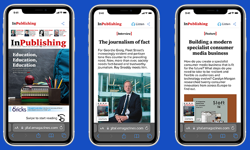Social media is not an area of expertise for me. Other than having my own private Facebook page, along with public Instagram and Twitter accounts, I don’t do much work on any social platform, either in terms of marketing or content delivery. I’m too busy project managing some kind of mass software migration for our digital magazines at the behest of head office, or working with the software dev team to agree and prioritise the list of requirements for the next app development sprint, estimating times for completion, testing, submission and release. And so on.
But come early January, a more coordinated social strategy for content and marketing will definitely be on my radar for Bauer’s ePublishing business, backed up by sound analytics and marketing tools that have been properly integrated into the new apps we’re about to release.
I’ll come back to this shortly.
At the end of October, I was at the ExCel Centre in London’s Docklands, as part of a Digital Innovations Summit. Sitting on a ‘panel’ of two (me and the rambunctious Keith Walker from Time Inc), I had to answer questions from an audience about media strategies, diversification of revenues and, inevitably, where we thought it was all going in the future.
One question was simply, “How do you compete with Facebook?” To which my somewhat obvious answer was, “You can’t”, before elaborating that, while you can’t compete with Facebook, you can most certainly benefit from it and use it effectively to make money.
Consider the following stats, which I stumbled upon while researching Zuckerberg and the gang’s Q3 year-to-date performance this year:
* Facebook now claims just short of 2bn monthly active users
* In September this year, some 1.2bn logged in daily
* Around 1bn of them were accessing their accounts via mobile
* Spending 20 minutes per visit on the app, on average
Almost a third of the globe’s population uses Facebook each month. Not only that, but engagement levels are through the roof – Facebook isn’t just somewhere to stay in touch with your mates any more. It’s the place to create, discover and share content; watch, broadcast or upload video (note the demise of Vine) and generally just hang out.
I’ve heard it said on many an occasion that Facebook is the enemy and publishers should have nothing to do with them. On the surface, I can understand that sentiment. Here after all is a platform that allows your magazine’s contributors to become your competitors.
Ignore Facebook, then? Or utilise? Seeing as we can’t compete, those are our two options, and I’m firmly in the camp that says utilising Facebook’s audience is the way forward. Which leads then to the 6.8 billion dollar question (Facebook’s ad revenue to end Q3 this year)… how do we do that?
I’ll start to answer that by asking another question: why let your editorial team spend valuable time and resource posting content if you don’t have a clue how much value it’s bringing you?
Surely only a coordinated approach to content publishing on Facebook, or any social media platform come to that, that’s backed up by targeted intelligent advertising (marketing) pushing users to some kind of revenue generator, with analytics telling us what works, is worth considering?
Before embarking on a marketing process, the first thing I always look for is complete clarity of purpose. What is it we want to achieve and get from our Facebook / social media audiences?
For my area of the Bauer business, the primary target would be to boost native app downloads from respective app stores. Because I know that, thanks to the incredibly smart CRM tools we’ve integrated with our apps, if I can just get people interested enough in the subject matter to download my app, then boom! I stand half a chance of getting them to buy something when they’re in it – whether it’s a single digital issue, or a digital subscription.
The real beauty of Facebook is that it’s allowed us, and others, to create and access massive specialist datasets. Ok, we don’t own that data, but with some investment we can market to it, possibly far more effectively than we can on other digital platforms.
Car plans
Let’s take Bauer’s flagship automotive brand, Car, as a case in point. Their editorial team has spent significant time and effort over the last five years growing its Facebook audience, integrating the platform with their overall content publication strategy to such an extent they can now boast nearly 1.2m likes on their page.
Working closely with the editorial team next year, we intend to put their hard-won Facebook audience to good use.
The marketers will know when a great piece of content is going to be posted on Facebook. They’ll know because the editorial team will tell them. Simultaneously, we’ll run our app acquisition campaigns. Then, when users download the app directly from this marketing, they are welcomed with a targeted, slick on-boarding message. They’re told how the app works, how wonderful it is. And they’re given instructions on how to get and use a voucher code we give them (in exchange for their data of course) that lets them download whatever freebies we’re giving away in the app as a reward for installing.
In the free issues, we can integrate and track upsell links to payment mechanisms or trial subs, whatever works best to achieve our ultimate goal – the user making an in-app purchase, or taking out a subscription.
Free downloads can showcase the editorial team’s excellent work, the app’s device optimisation, stability and excellent UX, and demonstrate clearly that the digital edition of Car is worth paying for and better than anything that can currently be found on Facebook.
Everything in the funnel is defined. Everything is trackable. Over time, analytics will tell us the best time – to the second, potentially – to post content that results in the biggest number of downloads (currently, for some reason, 7pm results in optimal click-throughs!).
Maybe I’m talking utter rubbish. Maybe people just don’t want to pay for digital editions of Car, or indeed anything that can be defined as digital content. Scepticism remains among many in the publishing industry about the future of digital magazines and paid-for digital content, and rightly so.
Time will tell. But if we can persuade just 1 per cent of those 1.2m people who liked Car on Facebook to download the magazine app and give it a go… well, it’ll be a start, won’t it?










